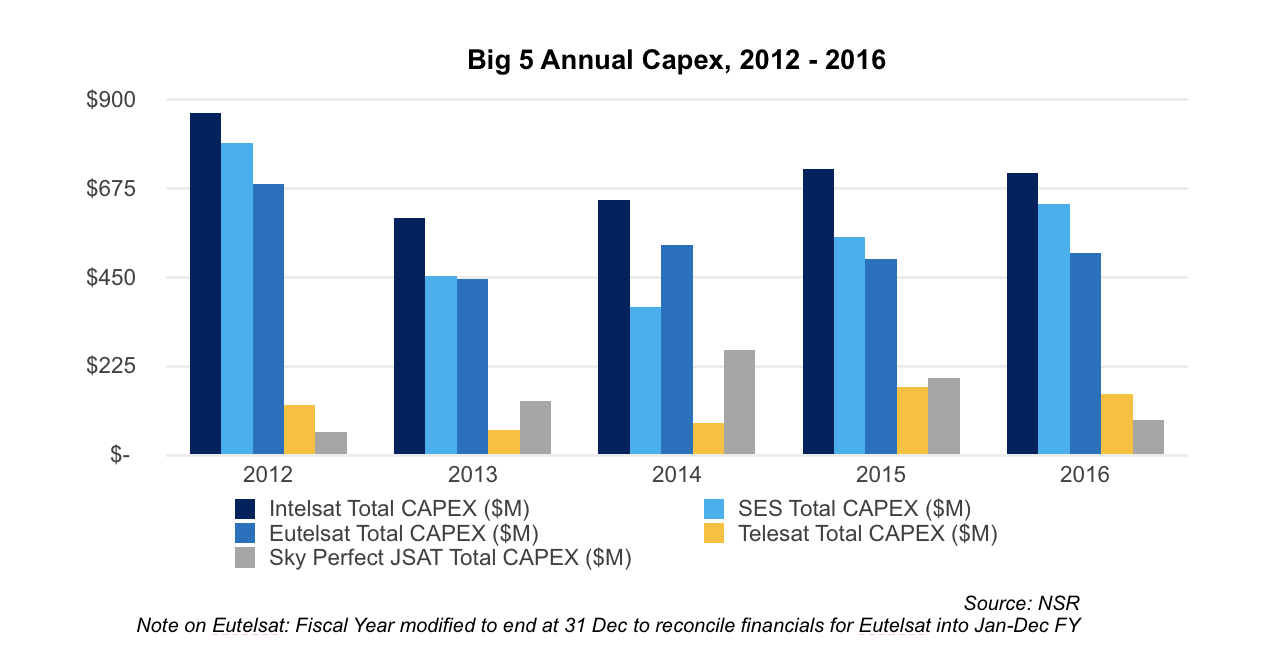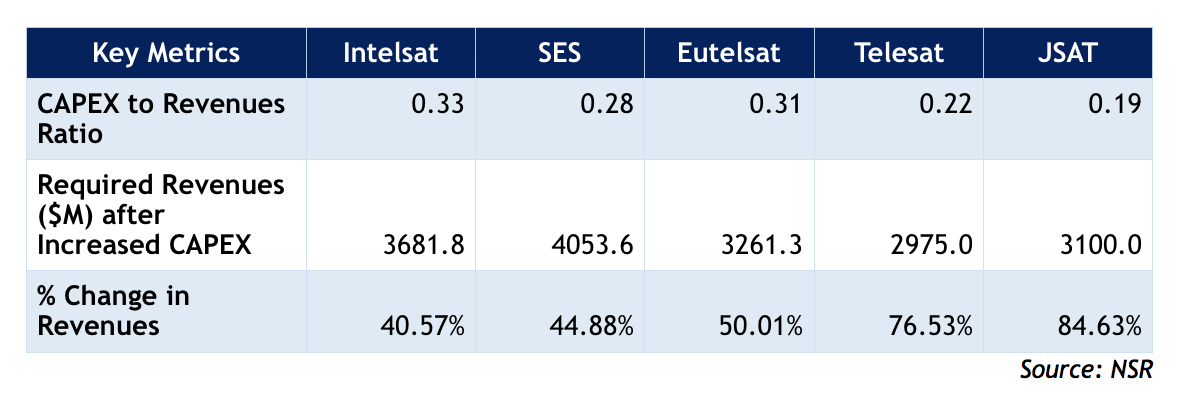Non-GEO Game
Plans and
Financial Play
Jun 14th,
2017
by
Gagan
Agrawal, NSR
The
satcom market is
rife with innovative
ideas and
constellations
targeting backhaul,
mobility, consumer
broadband and
government
verticals. In
response to this
proliferation of
business models,
traditional
satellite operators
are getting involved
in various
capacities to tap
into the demand
landscape, which can
be accessed through
LEO or MEO fleets.
These GEO-MEO-LEO
tie-ups occur while
operators are
already undertaking
aggressive GEO
capacity expansion
plans, leading to
highly complex and
speculative business
models, and
uncertain impact on
company financials.
Given this,
it’s important to
review the latent
demand verticals,
cost and CAPEX
scenarios for the
Big 5 (Intelsat,
SES, Eutelsat,
Telesat, and JSAT,
accounting for 60%
of global satcom
revenue) and finally
the impact of supply
and competition on
the winning
strategy.
To summarize the
current play for Big
5:
-
SES absorbed the
remaining 50.5%
of O3B for a
$1030M in 2016,
projecting
incremental
revenues of up
to ~$750M mostly
from O3B till
end-2021, with
focus on
verticals such
as trunking,
backhaul and
mobility.
-
Intelsat
invested $25M in
OneWeb in 2015
for exclusive
distribution
rights towards
aero/maritime,
government, oil
and gas, and
cellular
backhaul
markets. Though
the deal with
Softbank may
have fallen off,
Intelsat may bet
revenues on
GEO-LEO
synergies and
via a OneWeb
partnership.
-
Telesat has bet
on developing
its own LEO
constellation
focussing on
global
broadband,
possible
Canadian Govt.
programs, and
mobility
applications,
aiming to deploy
the full
constellation by
2021.
-
JSAT recently
invested an
undisclosed
amount in LeoSat
to become an
anchor investor
in the strategic
partnership.
With possible
realization of
investment
towards the
Series A $100M
funding round,
both bet on
verticals like
backhaul,
secured networks
for
banks/enterprises,
upload bandwidth
for
energy/maritime
operations,
emergency comm.,
and remote
connectivity.
-
Eutelsat is the
only major
satellite
operator to not
have disclosed a
non-GEO plan;
rather its
sticking to a
GEO-HTS/FSS
strategy and is
keen on vertical
strategic
partnerships
like with
Facebook for
broadband and
with ViaSat for
aero
connectivity,
while also
optimizing its
video business.
Crunching the
Numbers
Assessing CAPEX
intensive LEO plans
with respect to the
existing risk
appetite, and with a
nominal lifecycle
cost of $2.5B to
$3.5B for a
constellation, it is
understood that
significant uptake
of CAPEX would be
needed to deploy the
complete system. It
is assumed that all
each of the three
constellations (O3B,
Telesat LEO and
LeoSat) may cost
approx. between
$2.5B and $3.5B.

Spreading a
conservative cost of
$2.5B over 5 years
gives a $500M CAPEX
projection for each
year. Now, given
that LEO fleets
essentially target
data/mobility/government
type of
applications,
non-video CAPEX can
be considered for
appropriate
correspondence.
Assuming CAPEX
linearly varies with
revenues and that
non-video revenues
generally account
for 70% for most
global operators,
non-video CAPEX
would theoretically
be 30% of the total
CAPEX. Consequently,
it is derived that
each operator spends
considerably less on
von-video CAPEX than
the required CAPEX
($500M annually) for
building a LEO
fleet. Thus, even
with a cut in CAPEX
up to 20% using
organic measures, an
operator would find
it difficult to
absorb/raise an
extra $500M of CAPEX
per year (almost
tripling the spend
for SES/Eutelsat,
and 10 times for
Telesat), unless
there is specific
latent vertical
demand that can’t be
tapped through
existing (GEO) HTS
fleet investments.

But What About
Supply?
Analysing the supply
landscape, currently
less than 40% of
global GEO-HTS
capacity is
currently in use,
with demand lagging.
This will continue
to be the case with
current and upcoming
launches of HTS
payloads such as
SES-12/14/15, EpicNG
fleet, Telstar 18/19
Vantage, Ka-Sat and
Eutelsat 172B,
ViaSat and Hughes
satellites along
with regional HTS
capacities over
Latin America and
Asia regions. Most
of these HTS
satellites target
aero and maritime,
cellular backhaul,
mobility and
government markets;
e.g. similar to the
LEO systems—and
differentiation
becomes increasingly
hard for multiple
upcoming LEO fleets,
with corresponding
ground systems still
in question.
Thus, it becomes a
question of whether
anticipated demand
would materialize
within the payback
period, and if not,
what could be the
impact on the
finances of each
operator. Analysing
the CAPEX to
revenues ratios as
provided in NSR’s
Satellite Operator
Financial Analysis,
7th
Edition, with an
increase in CAPEX of
$500M, revenues
would need to
increase by as much
as 40% to 85% for
the Big 5 operators
for an assumed
constant CAPEX to
revenues ratio, as
shown in the table
below. SES, with a
$750M incremental
revenue forecast
till 2021, is below
the 40%-85% bar with
33% increase in
revenues (as of
2016), by having
executed a largely
cash-based deal to
nullify debt towards
long term CAPEX
(~$1.5-$2 billion),
maintaining the Net
Debt to EBITDA ratio
below 3 to maintain
its investment grade
rating. Thus, it
remains to be seen
whether a
cash-strapped
Telesat with EBITDA
of ~$570M can
achieve the same
CAPEX to revenues
ratio to maintain a
healthy turnover
ratio (~0.15-0.18)
with a Net Debt to
EBITDA ratio below
4, given the yearly
CAPEX investment is
almost 10 times
higher compared to
the non-video CAPEX.

Bottom Line
Intelsat and JSAT,
with strategic
partnerships, have a
very limited play in
this arena, low
upside, but are
essentially risk
free and on an
organic pattern to
their growth, while
simultaneously
developing a service
provider based
distribution
business that can
rival the other
three big operators.
Eutelsat, as well,
banks on a similar
strategy with
limited upside and
organic growth
through vertical
strategic
partnerships with
service providers
for its GEO-HTS and
FSS fleet. For the
first time, the
industry sees a
regional operator in
Telesat going
aggressive with LEO
plans with a launch
timeframe
competitive to
OneWeb and more than
50% increase in
revenues in the
medium to long term,
although with a low
ability compared to
Top 3 with respect
to EBITDA, and a
risk of high
exposure - in case
revenues don’t
materialize in the
payback period. SES
bet early with an
investment of $75M
in O3B and, with the
recent acquisition
(and low CAPEX
compared to LEO
fleet), has
materialized MEO-GEO
synergies into one
of the more
promising growth
areas in the near
term.
Questions remain
though, that had the
Softbank led
Intelsat-OneWeb
merger not failed,
and with cash
infusion of
$500-600M per year
towards CAPEX for
OneWeb, and an
improved debt
profile for
Intelsat, would that
have been a turning
point in the Big 5
play? Could
Intelsat with OneWeb
have mustered growth
(for a similar CAPEX
to revenues ratio)
through a well-built
distribution network
from the partners
associated, pushing
other operators out
of the game?
Ultimately Intelsat
and OneWeb playing
fragmented roles in
the industry may be
a win for other
global operators to
further their
LEO/MEO ambitions.






